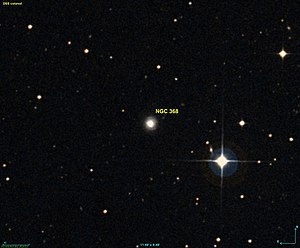NGC 368
| Galaxy data from NGC 368 |
|
|---|---|

|
|
| AladinLite | |
| Constellation | Phoenix |
|
Position equinox : J2000.0 , epoch : J2000.0 |
|
| Right ascension | 01 h 04 m 22.0 s |
| declination | -43 ° 16 ′ 36 ″ |
| Appearance | |
| Morphological type | (R?) SA (rl:) 0 ^ +: |
| Brightness (visual) | 13.8 mag |
| Brightness (B-band) | 14.7 mag |
| Angular expansion | 0.7 ′ × 0.6 ′ |
| Surface brightness | 12.7 mag / arcmin² |
| Physical data | |
| Redshift | 0.029450 ± 0.000130 |
| Radial velocity | 8829 ± 39 km / s |
|
Stroke distance v rad / H 0 |
(392 ± 27) x 10 6 ly (120.1 ± 8.4) Mpc |
| history | |
| discovery | John Herschel |
| Discovery date | September 5, 1834 |
| Catalog names | |
| NGC 368 • PGC 3826 • ESO 243-023 • 2MASX J01042204-4316363 • GC 196 • h 4012 • | |
NGC 368 is a lenticular galaxy of the Hubble type SB0 / a in the constellation Phoenix in the southern sky . It is estimated to be 392 million light years from the Milky Way and about 80,000 light years in diameter.
The object was discovered on September 5, 1834 by the British astronomer John Frederick William Herschel .
